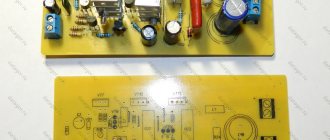Pulsar sensor connection diagram
Fire detector “Pulsar 1”“
Pulsar 1-01N”, “Pulsar 1-01S”, “Pulsar 1- 010N”,
“Pulsar 1-010С”, “Pulsar 1-011Н”, “Pulsar 1-011С”
Purpose and principle of operation
The Pulsar1 fire detector is designed to detect fires accompanied by the appearance of an open flame.
It operates via a two-wire line in conjunction with control and control devices such as PPS-3, PPK-2, Signal-VK, Signal-4, Signal-20, Raduga-2 and similar. The detector is a restoreable serviceable device. When a fire is detected, it issues an “Alarm” signal to the alarm system loop and to the light indicator located in the detector body.
The operating principle of the Pulsar 1 detector is based on the conversion of infrared (IR) radiation in the range of 0.8 - 1.1 microns, located in the field of view of the sensitive element, into an electrical signal.
Designation of the detector when ordering it and in the documentation of other products in which it can be used: Fire flame detector “Pulsar1-NNNNN”, Cable KE1/L, TU 44371-010-26289848-01, where NNNNN designation of the required version of the detector in accordance with Table 1. The letter “N” at the end of the name indicates a normal version with an operating temperature range: -10°C - +55°C. The letter “C” at the end of the name indicates a special version with an operating temperature range: -50°C. +55°С. Cable KE1 type “twisted pair in the screen”. The KE2 cable of the “twisted pair in the screen” type is equipped with a connector for connecting to the main unit. The letter “L” in the cable name indicates the length of the cable.
Table 1
Detector model
| Design and functional features | Shell protection degree | ||
| Detector | Feelings element | ||
| Pulsar1-01N Pulsar 1-01S | The sensitive element is located in the detector body. | IP 41 IP 41 | IP 41 IP 41 |
| Pulsar 1-010N Pulsar 1-010S | The sensing element is located in a rotating device on the detector body. | IP 41 IP 41 | IP 51 IP 51 |
| Pulsar 1-011N Pulsar 1-011S | The sensitive element is carried out on a “twisted pair in the screen” cable with a length of 0.5-25m | IP 41 IP 41 | IP 51 IP 51 |
Projection of the field of view of the detector sensitive element Technical characteristics
- Detection range of a test flame source, m. TP-5 source (petroleum products) with an area of 0.1 sq.m * switch L=0. thirty
- switch L=1. 15
- hearth TP-6 (alcohols) with an area of 0.1 sq.m **
- switch L=1. 6
- Response time, sec:
- switch T=0. 4.5
- switch T=1. 9
- Recovery time to standby mode from “Fire” mode, sec. 2+0.2
- Viewing angle, degrees. 120
- Length of electric cable for remote sensing element upon request, m. 0.5-25
- Permissible background illumination without modulation 2-10 Hz, no more than lux:
- radiation from incandescent lamps. 500
- radiation from fluorescent lamps. 2500
- Supply voltage, V. 9-28
- Current consumption in standby mode from the power source, no more than mA. 0.3
- Loop load resistance in “Alarm” mode, Ohm. 1000
- Operating temperature range (see Purpose and principle of operation)
- Enclosure protection degree (see Table 1)
- Overall dimensions, mm:
- remote sensitive element. 12*12*20
- Detector weight, no more than kg. 0.6
- Product service life, years. 10
- switch L=0. 12
- scattered solar radiation. 15000
- detector, nothing more. 150*80*45
*Note 1:
Initial factory settings of the switches: L=0, T=1
**Note 2:
The detector allows a polarity reversal of the supply voltage if the ratio of the polarity reversal period to the pulse duration of the opposite polarity is at least 7.0. In addition, so that the polarity reversal does not affect the registration of flame pulsations, the polarity reversal period must be either more than 500 ms (in PPK-2) or less than 50 ms (in “Gamma-01”). For example:
- The polarity reversal period is 900 ms, the pulse duration is 100 ms. Then 900ms./100ms.=9.0.
- the polarity reversal period is 1100 ms, the pulse duration is 150 ms, then 1100 ms/150 ms = 7.3
Composition of the detector
The detector body is made of 1 mm thick steel using bending and argon welding (Fig. 1). The detector body contains an electronic board covered with a screen. To indicate the “Fire” mode, a red LED is placed on the front surface of the case. The detector body is sealed by the manufacturer. The socket (Fig. 2) has two holes with a diameter of 5 mm for fastening, the distance between which is 70 mm. At the bottom of the socket there is an XP1 terminal block for connecting a cable. There are three electrodes on the block, each of which has M3 screws for connecting the cable. The housing is hung on the socket and secured with M3 screws through three holes on the front part. To ensure the required degree of shell protection, the holes are closed with a valve. Simultaneously with the mechanical fastening, the detector is electrically connected to the loop.
Fig 1.
Fire flame detector “Pulsar 1-01N” with removed socket
Design and operation of the detector
The functional diagram of the detector is shown in Fig. 1. The projection of the field of view of the sensitive element onto a plane parallel to its optical axis is shown in Fig. 2. Timing diagrams of operation are shown in Fig. 3. The optical signal of an open flame in the IR radiation range is supplied to a primary transducer (PC), which converts the photosignal into an electrical parameter - resistance. To perform special functions (difficulty of access, increased protection of the PCB, industrial design), the PCB is carried on an electric cable to the control zone. The secondary converter (STC) converts the resistance of the PP into voltage. The variable component of the signal is amplified by an amplifier with an adjustable gain factor (AG). Its adjustment determines the fire detection range. Range switch L sets the maximum fire detection range to 30 meters (L=0) or a reduced range of 15 meters (L=1). The signal components characteristic of a flickering flame are isolated using a bandpass filter (BPF). To increase the device's security against optical interference, flicker pulses pass through a limiter (LGN), which has a dead zone (Fig. 3). The signal from the output of the fire generator goes to the pulse shaper (PI). The pulse shaper generates a single pulse of a fixed duration for each decline in the pulse from the ignitor. The accumulation of flickering flame pulsations is carried out in a storage unit (NCU) (Fig. 3). The signal from the output of the storage node goes to the formation circuit (SF). If the signal exceeds a given level, the SF issues a control signal to the key device (KU). The pulse accumulation time is set by the time switch T: standard time 4.5 seconds (T=0) or increased detector response time 9 seconds (T=1). The key device connects a resistor Rb with a resistance of 1000 Ohms to the loop, which leads to an increase in the loop current and the indicator (I) on the front panel of the detector turns on. The detector returns to standby mode after removing the supply voltage from the loop for at least two seconds. The detector is powered by voltages +6V and +3V, generated by a voltage stabilizer (VST). The voltage from the alarm loop through the detachable connection XP1 is supplied through a half-wave rectifier (VR) to the STN input. A rectifier is necessary when working with a loop that has voltage reversal to control it for a break.
Rice. 1.
Functional diagram
Rice. 2.
Projection of the field of view of the detector's sensitive element
Rice. 3.
Timing diagrams
Marking and sealing
The following markings are applied to the detector body:
- symbol of the detector in accordance with Table 1: “Fire detector Pulsar 1-NNNNN”;
- name of the enterprise “KB Pribor”;
- date of manufacture;
- factory number;
- quality control sign;
- degree of shell protection;
- supply voltage and pin markings.
Marking is applied using silk-screen printing or self-adhesive labels.
Table 1
| Detector model | Design and functional features | Shell protection degree | |
| Detector | Feelings element | ||
| Pulsar1-01N Pulsar 1-01S | The sensitive element is located in the detector body. | IP 41 IP 41 | IP 41 IP 41 |
| Pulsar 1-010N Pulsar 1-010S | The sensing element is located in a rotating device on the detector body. | IP 41 IP 41 | IP 51 IP 51 |
| Pulsar 1-011N Pulsar 1-011S | The sensitive element is carried out on a “twisted pair in the screen” cable with a length of 0.5-25m | IP 41 IP 41 | IP 51 IP 51 |
Package
- The detectors are packaged complete in the manufacturer's packaging. Before packaging, the detectors are preserved in accordance with GOST 9.014-78 for group V3-10, internal packaging option VU-5 in accordance with GOST 9.014-78.
- Detectors are placed in containers to prevent their movement.
- Each transport container contains:
- packing list;
- accompanying documentation in a waterproof bag.
Operating restrictions
- The detector must be operated in accordance with the current Electrical Installation Rules, this Maintenance Manual and other regulatory documents in force at the enterprise.
- Persons who have studied this maintenance and undergone appropriate instruction must be allowed to operate the detector.
Preparing the detector for operation
- Remove the detector from the shipping container, slide the protective bolt, unscrew three M3 screws through the holes on the front side of the detector, and remove the socket.
- Mount the socket either on a swivel bracket or directly on a building element in accordance with the design according to Fig. 1. For mounting in the socket there are two 5 mm mounting holes at a distance of 70 mm.
- Connect the cable wires to the XP1 terminal block located on the socket in accordance with Fig. 1, observing polarity. To connect, use M3 screws located on the electrodes.
- Set the response time on the detector board using switch T (position 17 in Fig. 2) to 4.5 seconds (T=0), or an increased time of 9 seconds (T=1). An increased response time is selected to increase the noise immunity of the detector.
- Using switch L (position 12 in Fig. 2), set the detection range to 30m (L=0), or reduced range to 15m (L=1). Reduced range - in case of optical interference and small room sizes.
- To modify “Pulsar1-011”, install an electrical communication channel between the electronic unit and an external sensitive element in accordance with the project. Secure the remote sensor element using a bracket.
- Place the detector housing on the socket and secure it with three M3 screws through the three holes on the front of the housing. In this case, simultaneously with the mechanical fastening, the detector is electrically connected to the loop.
- Orient the direction of the optical axis in accordance with the project.
Fig.1
Scheme for connecting several “Pulsar 1-01N” detectors into one loop of the control device
Installation recommendations
The field of view of the sensitive element should be oriented so that it is not affected by rotating or oscillating elements with a frequency of 2-20 Hz that modulate solar or artificial lighting. It is recommended to install the sensitive element so that the optical axis is directed in the direction opposite to the window openings. Direct solar radiation (or specular glare) is not allowed to enter the field of view of the sensitive element. When installing the detector outdoors, it is advisable to orient the optical axis of the sensitive element to the north. Bulky objects blocking the field of view will make it difficult to detect fires occurring behind these objects, which should be taken into account during design. In rooms, it is recommended to orient the optical axis of the detector from the window openings to the inside of the room. If there are partitions, shelving, or bulky equipment, additional detectors should be installed to monitor “shadow” areas (see Fig. 1). It is recommended to use flame detectors (NPB 88-2001) in:
- industrial buildings with the production and storage of: wood products, synthetic resins, synthetic fibers, polymer materials, textiles, clothing, footwear, tobacco, fur, and pulp and paper products, celluloid, rubber, rubber products, flammable X-ray and film films, cotton, varnishes, paints, solvents, flammable liquids, flammable liquids, lubricants, chemical reagents, alcoholic beverages, alkali metals, metal powders, flour, animal feed, other products and materials that emit dust;
- rooms for equipment and pipelines for pumping flammable liquids and oils, for testing internal combustion engines and fuel equipment, filling cylinders with flammable gases;
- premises of automobile service enterprises;
- premises of artistic, costume, restoration workshops, cinema and light projection, equipment, darkrooms;
- premises of museums and exhibitions.
Set “Pulsar1-01”
The appearance of the product is shown in Fig. 2. The detector's field of view is a cone (Fig. 3) with an apex angle of 120°. When installing the detector on a wall, the walls, floor, and ceiling of the room will be monitored.
The field of view is a cone with an apex angle of 120° (Fig. 2), the direction of the optical axis can change relative to the detector body vertically by 60°, horizontally by 90°.
A distinctive feature of the kit is a remote sensitive element. This allows you to monitor hard-to-reach and local areas, and easily place the sensitive element in interior details (decorative panels, suspended ceilings, etc.). It is possible to install the detector in one room (for example, a corridor), and the sensitive element in a restricted access room (storage, warehouse). The field of view is a cone with an apex angle of 120° (Fig. 3), the direction of the optical axis can change relative to the plane of the detector mounting vertically by 60°, horizontally by 90°.
Fig.1
Installation recommendations
Fig.2
Fire flame detector “Pulsar 1-01N” with removed socket
Fig.3
Projection of the field of view of the detector's sensitive element
Checking the functionality of the detector
Apply supply voltage to the detector in accordance with the technical requirements. Switch the detector to the “Alarm” mode using one of the following methods:
- In accordance with GOST 50898-96, install a TP-5 test center along the optical axis of the detector at a distance of no more than 30 m. Install a light-proof partition between the detector and the test source. The area of the hearth is 0.1 sq. m. (capacity 33*33*5 cm). Pour gasoline into the container in the amount of 2000. Light the gasoline in compliance with safety regulations, let it burn, and then remove the light-proof partition. Subject the detector to the radiation of the test fire flame. If the detector was triggered in no more than 3-12 s, then it complies with the specifications.
- Along the optical axis of the external optical element, install the flame source at a distance of no more than 3 m. The area of the outbreak is 0.001 m². (capacity 33*33*50 mm). Pour 40 g of gasoline into the container. Such a fire is equivalent in impact to a TP-5 test fire with an area of 0.1 m. Set the gasoline on fire and let it flare up. The response time should not exceed 3-12 s.
- A stearine candle with a diameter of 25 mm and a flame size of 3-4 cm oscillates with a frequency of 7-10 Hz at a distance of 150-200 cm from the detector within the field of view. The response time should not exceed 7-20 s.
- Radiation from the test radiation source T-07 is directed to the sensitive element of the detector at a distance of no more than 15 m. If the radiation hits exactly, the response time should not exceed 7 s. You can set the field of view optimally, for example, orient the optical axis diagonally across the room.
Resistance to direct light in accordance with European standard EN-54
During the operation of the detector, maintenance (TO) should be carried out with periodic performance monitoring in the scope of TO-1 and TO-2. TO-1 includes blowing the input window of the remote optical element with compressed air of 0.3 or more kgf/cm, which does not contain drops of oil and water. TO-2 involves wiping the input window of the remote optical element with a soft cloth soaked in gasoline or alcohol.
Recommended maintenance frequency (months):
- offices, residential premises TO-1. 6
- TO-2. 12
- TO-1. 4
- TO-2. 12
- TO-1. 3
- TO-2. 6
After the maintenance, the functionality of the detector should be checked.
Storage
During storage, the detector must be in the manufacturer's packaging in heated storage conditions at an ambient temperature from plus 5°C to plus 40°C and a relative humidity of no more than 80% at a temperature of plus 25°C without moisture condensation.
The storage room should be free of conductive dust, acid and alkali vapors, as well as gases that cause corrosion and destroy insulation. Transportation
Detectors are transported in the manufacturer's containers by all types of transport (railway cars, closed cars, sealed heated compartments of aircraft, holds, etc.) over any distance.
Source











